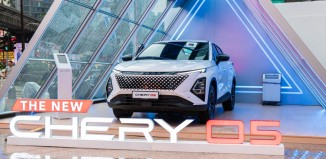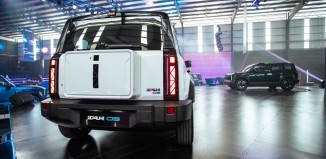Ford’s ‘Green’ SUV
With a chairman (44-year old Bill Ford) who is especially concerned about the environment, Ford Motor Company has, in recent years, embarked on an extensive program to offer more environment-friendly vehicles. As one of the companies which makes and sells the most automobiles in the world, it realizes that its products obviously make a major impact on the environment with the amounts of exhaust gases generated, as well as the millions of litres of fuel consumed.
Like many other automakers, Ford has been spending a lot of money on R&D into environment-friendly vehicles. The company introduced its “Cleaner, Safer, Sooner” commitment in 1998 by making U.S. and Canadian SUVs and Windstar minivans low emissions vehicles (LEVs) ahead of any US regulatory requirement. The next year, Ford expanded its LEV commitment to its F-Series pickup trucks. In Europe, the company has moved ahead of stage IV requirements by nearly five years. By January 2000, Ford had more than 2 million vehicles on the road that operated significantly cleaner than the local regulatory requirement.
In addition, Ford is the industry leader in the production and sale of alternative fuel vehicles, including cars and trucks powered by natural gas, propane and electricity. Natural gas versions of the Ford F-Series and Econoline were the first vehicles to be certified as SULEV under the strict criteria of the California Air Resources Board. Ford also has more zero-emissions electric vehicles on the road in North America than any other automaker.
Not content with its industry-leading position, Ford continues to develop other types of vehicles that are more environment-friendly and within just two years, it will offer a sport utility vehicle (SUV) with a hybrid powerplant.
Based on the present Escape model, the Escape HEV (hybrid-electric vehicle), as it is known, is being claimed as ‘the cleanest, most fuel-efficient SUV on the planet when it goes on sale in 2003′. It will be the first production SUV with a hybrid powerplant but not the first SUV with an alternative powerplant; some years ago, Toyota began offering its RAV4 model with an electric engine in some countries.
The Escape HEV will feature an electric drivetrain combined with a fuel-efficient 4-cylinder petrol engine. With regenerative braking and nearly instantaneous start-stop capability, the Escape HEV will be especially fuel-efficient in the city, delivering about 40 USmpg (about 17 kms per litre or 48 mpg) in urban driving conditions. The hybrid Escape will be capable of being driven more than 900 kms on a single tank of petrol. It will, however, have acceleration performance similar to an Escape equipped with a 3.0-litre V-6 engine.
“The Escape HEV will be a ‘no-compromise’ family-sized hybrid electric vehicle that achieves superior fuel economy and low emissions without sacrificing performance, roominess or affordability,” said Jim O’Connor, president, Ford Division.
Prototypes of the Escape HEV are presently undergoing rigorous testing to ensure the vehicle is “Built Ford Tough.” Like the current production Escape with petrol engine, it will have 4×4 capability, the same ground clearance and comparable cargo capacity.
The Escape HEV drive system combines a 65 kW permanent magnetic electric motor and 28 kW generator with an Atkinson cycle variant of the Escape’s Zetec 2.0-litre 4-cylinder engine. The Atkinson cycle engine is significantly more efficient than a conventional four-stroke Otto cycle engine. The increase in efficiency is due to controlling pumping losses and optimizing the expansion ratio, while maintaining a constant compression ratio.
The Atkinson cycle, also called the “5-stroke cycle”, works like this: intake, back-flow (partial expulsion to eliminate pumping losses), compression, expansion and exhaust. Based on this cycle, the combustion chamber volume is adapted to maintain a constant compression ratio for each load level while varying the expansion ratio to optimize efficiency. Low-end torque losses, which are characteristic of 5-stroke cycle engines, can be overcome with the assistance of an electric drive motor, making the Atkinson cycle ideal for hybridization.
The electric drive motor is used to increase the performance of the internal combustion (IC) engine, stop and restart the IC engine when the vehicle is at rest, drive the vehicle at low speeds, recharge the 300V traction battery and recapture braking energy – called regenerative braking. Sanyo Electric has been selected as the exclusive supplier of the nickel-metal hydride batteries for the Escape HEV.
These and other related technologies have been developed and proven during Ford’s P2000 research program.
The Escape HEV is being designed to operate cleaner than government regulations require. In fact, it will qualify as a Super Ultra Low Emissions Vehicle (SULEV) under California emissions standards. It will also meet Stage IV emissions requirements in Europe before they become mandatory in the 2005 model year.
While a few automakers have introduced small, low-volume hybrid electric cars, Ford is introducing its first HEV in a family-sized sport utility to increase customer appeal. This hybrid-electric powertrain also has been developed with additional applications and vehicle platforms in mind to expand the potential impact of the environmentally-responsible technology.
“The most impressive technology in the world cannot make a measurable difference in addressing global concerns until it is applied in large-volume production,” Mr O’Connor said. “Ford has consistently worked for high-volume solutions that don’t require our customers to make compromises. The Escape HEV will continue in that tradition.”























